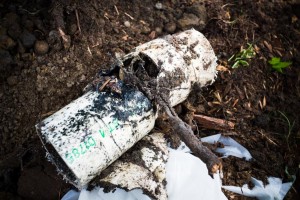I love trees. But I don’t love them in my sewer. If you read Sewer Lateral Woes, Part I, you know I’ve been dealing with a root-infested sewer lateral. An oak tree was planted right next to the pipe that connects my home’s plumbing to the city-owned sewer pipeline, and over the years its roots made their way into the pipe, slowly blocking the wastewater leaving our home. There’s nothing like sewage backing up into your bathtub to get your attention, trust me. A cracked sewer lateral also means water can get into the sewer system, which can lead to sewer overflows that pollute the environment. Any kind of sewage spill, whether in a tub or a local river, is bad news.
After some careful digging we found the sewer lateral.In Part I I left you with my dilemma: to cut or not to cut down the tree? If I removed it, it could never pose a threat to my sewer lateral again, but being the tree-hugging type I really wanted to avoid this if I could. There was a Mallard duck incubating eggs close to the tree so I took a few weeks to think about it, but once the ducklings hatched and took off with mama down to the water it was time for action. Unfortunately, the mama duck was not interested in my blog and snuck her babies off before I could get a photo of them (sorry).
I consulted with several professionals before ultimately deciding that both our sewer lateral and the tree could be saved! PVC pipe, which my lateral is made out of, does not typically have issues with tree roots. It seemed more likely that an improper installation had compromised a pipe joint, allowing the tree roots to get in. Roots seek out water and nutrients, and since sewer laterals have plenty of both, even a tiny crack will attract small hair-like roots into the pipe. We decided to replace the broken section of pipe and leave the tree alone. Win for Mr. Tree. In just a few short hours the broken section of pipe was located and replaced. Take a look at the photos from the repair (click the photos to enlarge), that was one busted lateral!
Since the broken section was small, we don’t think our digging did any major harm to the tree. Disturbing too many roots could kill it, but we are optimistic that both sewer and tree are in the best of health. If you suspect roots in your sewer lateral, make sure to get a professional opinion. Unfortunately, sometimes trees do need to be removed because of future damage they can cause or the damage that will be done to the tree during the sewer repair.
But that’s not all the good news I have to share! I am happy to report that shortly after the repair was complete, ANOTHER mama duck happily incubated her eggs right under the oak tree. It seems I am not the only one who is glad the tree stayed.
HRSD’s SLIP pilot project is helping homeowners in Hampton Roads identify and repair defective laterals at no cost, with repairs currently underway in the Campostella neighborhood in Norfolk. Check out these videos of water entering a lateral and roots entering a lateral and see for yourself what root intrusion means to your sewer and how rain and groundwater can enter the sewer system and cause overflows. Even if you are not in a SLIP pilot neighborhood, you can still help prevent sewer overflows by keeping your lateral in mind when you plan your landscaping. Plant trees and shrubs away from your sewer lateral and chose types with less invasive root systems. And of course, never treat your toilet or any household drain as a trashcan. Knowing what to flush will keep our pipelines flowing…and your bathtub sewage-free.

